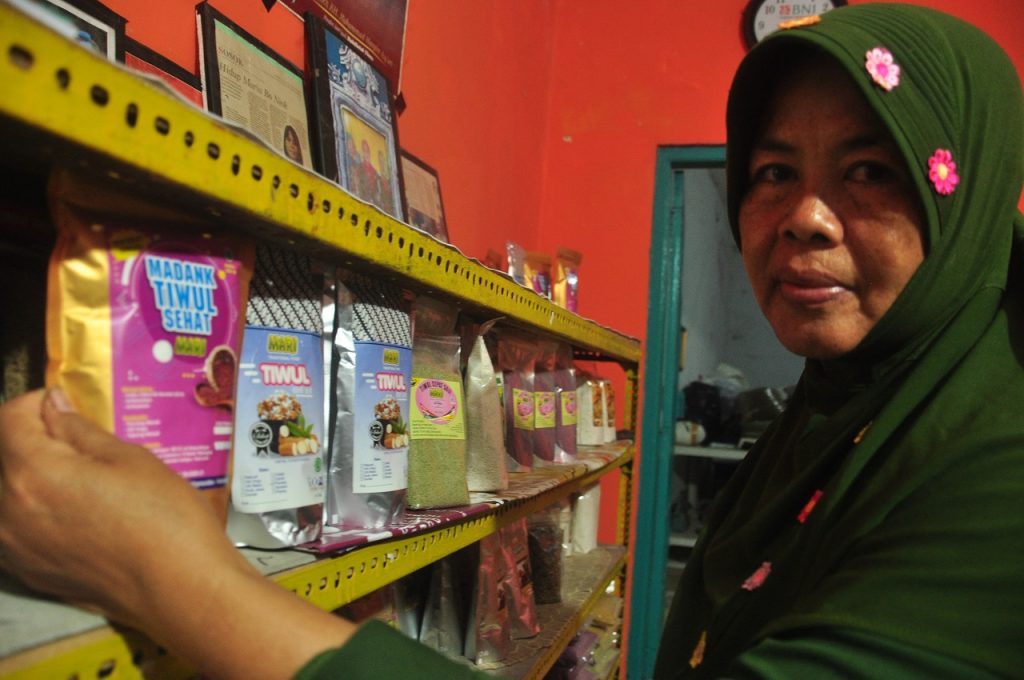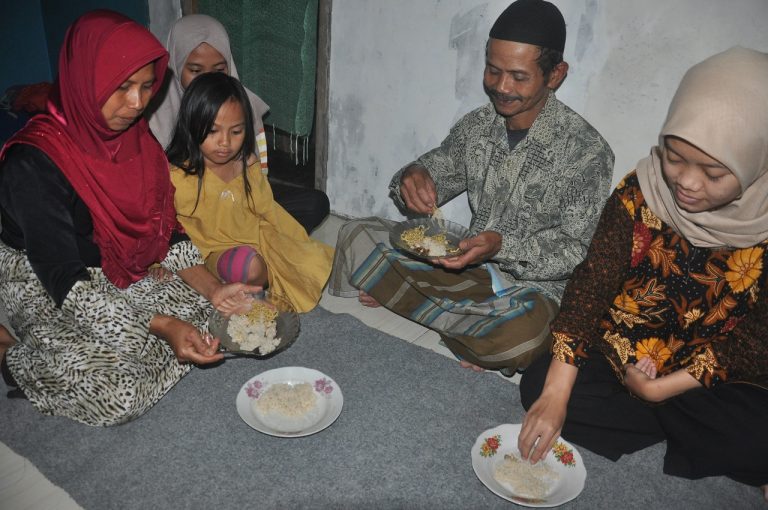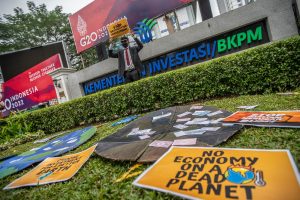Removing the stigma of “poor people’s food” as a symbol of food security
by: Hartatik
Wonosobo – The sound of spoons clattering against pans can be heard faintly from the kitchen on the second floor of a simple house in Pasunten Hamlet. In the drying room, Siti Maryam (55), who is fondly known as Maria Bo Niok, is diligently turning over grains of cassava flour.
“This way, it dries quickly. Later, it can be processed into instant tiwul,” he said while wiping sweat from his forehead.
For more than a decade, Maria Bo Niok has devoted her life to a simple yet meaningful mission: elevating the status of leye and tiwul—two local cassava-based foods that were once considered the food of the poor.
In Maria Bo Niok’s hands, leye and tiwul are not just food. They are stories about dignity, struggle, and the big dreams of a village in Wonosobo that wants to make its mark on the world stage.
Maria still remembers her childhood very well. Leye, the cassava rice that her mother cooked, was often the subject of ridicule.
“Leye was considered food for poor people,” she recalled.
The stigma stuck with him even into adulthood. However, life brought her to a turning point. After working as a migrant labourer, she returned to her village with strong determination. She saw that farmers’ cassava harvests were often undervalued, fetching only IDR 700 (USD 0.042) per kilogram from middlemen. “But cassava is gold if processed properly,” she said.

The rise of instant tiwul innovation
In 2008, Maria began a simple experiment by processing cassava into leye and tiwul. Not stopping there, she tried to turn it into an instant product with a variety of flavours—from pandan, palm sugar, to purple sweet potato. The journey was not easy.
“It took two years to find the formula for long-lasting instant tiwul,” she said.
However, the hard work pays off. Now, “Tiwul Instan Mari” products are often ordered from overseas. Migrant workers in Hong Kong and Malaysia are loyal customers, and there are even regular orders from Jakarta to be sent to Abu Dhabi.
“People used to be ashamed to eat leye, but now some comment, ‘selling tiwul for the price of gold,'” Maria chuckled.
For Maria, her venture is about more than just business. She established the Martani farmer group, bringing together over 20 cassava farmers to process their harvests collectively. The price she offers—IDR 2,000 (USD 0.12) per kilogram—is significantly higher than what middlemen typically pay, ensuring that local farmers also benefit from the value of their own produce.
“There are farmers who send up to four tons of cassava, saying that it’s okay to be paid later. They trust us,” he said softly.
Nowadays, cassava is no longer just a cheap commodity. It has become a source of livelihood, pride, and a symbol of local food security.
From the village to the world
Maria’s instant tiwul products are now available in shopping centres across major cities and have even been featured at Soekarno-Hatta Airport near Jakarta. Their distinctive flavours and blend of tradition and convenience have made them especially appealing to modern consumers.
Maria’s obsession is now simple but ambitious: to produce instant tiwul in sachets that can be sold in small shops and even on the international market.
“If instant noodles can go global, why can’t tiwul?” she said confidently.
Despite being from an older generation, Maria’s enthusiasm is a great inspiration to the millennials in her village. She often encourages young people to learn how to process cassava, package products, and even sell them through marketplaces.
“Young people should not be ashamed of their traditional food. In fact, they should be at the forefront of preserving it,” she said.
From a health perspective, both leye rice and tiwul contain various nutrients. They are even suitable as alternative foods for diets and diabetics. Based on laboratory test results from the Central Java Food and Drug Administration, 100 grams of leye rice contains 80 grams of carbohydrates, 1.5 grams of protein, 0.3 grams of fat, 33 mg of calcium, and 61 mg of phosphorus.
Meanwhile, according to a research journal from the Department of Government Science, Faculty of Social and Political Sciences, Diponegoro University, titled Institutional Patterns of Households in Realising Local Wisdom-Based Food Security in Giyombong Village, Bruno District, Purworejo Regency, the main nutrient needed by humans—carbohydrates—is found abundantly in leye, which contains about 80 grams of carbohydrates per 100 grams.
According to health analyses, humans require around 2 grams of carbohydrates per kilogram of body weight. For instance, someone weighing 70 kilograms needs approximately 140 grams of carbohydrates per day. In the study, each household typically prepared one basket of rice daily, with each person consuming about one 200-gram plate per meal—providing roughly 160 grams of carbohydrates, enough to meet the community’s daily nutritional needs.
Other nutrients such as vitamin A, protein, fat, calcium, and phosphorus are complementary nutrients that can be obtained from foods other than leye.
Stagnant
Although the consumption of leye rice remains strong today, the development of this local food product has largely stagnated. Mutmainah, a leye producer and cassava processor from Kaliwiro, Wonosobo, has been active in promoting local food since 2010 as a member of the Mainstay Farmers and Fishermen Group (KTNA) and the Women Farmers Group (KWT). She shared that despite her efforts, local food products like hers have yet to receive meaningful support from relevant government agencies.
“I once proposed that the local government offices use local food products—such as mocaf (modified cassava) flour—as ingredients for snacks. But so far, there has been no follow-up,” she said. “So we only produce when there are special events or competitions.”
According to the Food Security Agency, cassava is a high-fibre food with a low glycemic index, making it highly beneficial for preventing diabetes.
Quoting from the book Diversification of Local Food for Food Security: Economic, Social, and Cultural Perspectives by Wuryaningsih Dwi Sayekti, Dyah Aring Hepiana Lestari, and Tyas Sekartiara Syafani, preference plays a key role in shaping people’s consumption patterns of processed cassava. To enhance public preference for local food, the authors suggest that the government should adopt policies supporting the production, distribution, and consumption of these local food products.
Initiatives such as local food labels, education and promotion programs, tax incentives, and financial support for local farmers and producers can help create an environment conducive to local food.
Read the previous part: https://tanahair.net/from-villages-to-social-media-how-millennials-preserve-nasi-leye-1-3/
Continue reading Part 3: https://tanahair.net/from-villages-to-social-media-how-millennials-preserve-nasi-leye-3-3/
Banner photo: The Fitriyah family enjoying a plate of leye together in a cosy atmosphere. (Hartatik)
This coverage is part of the “Journalist Fellowship and Mentorship Program for Sustainable Food System 2025” scholarship supported by the Sustainable Food System Coalition (KSPL) in collaboration with AJI Jakarta.















